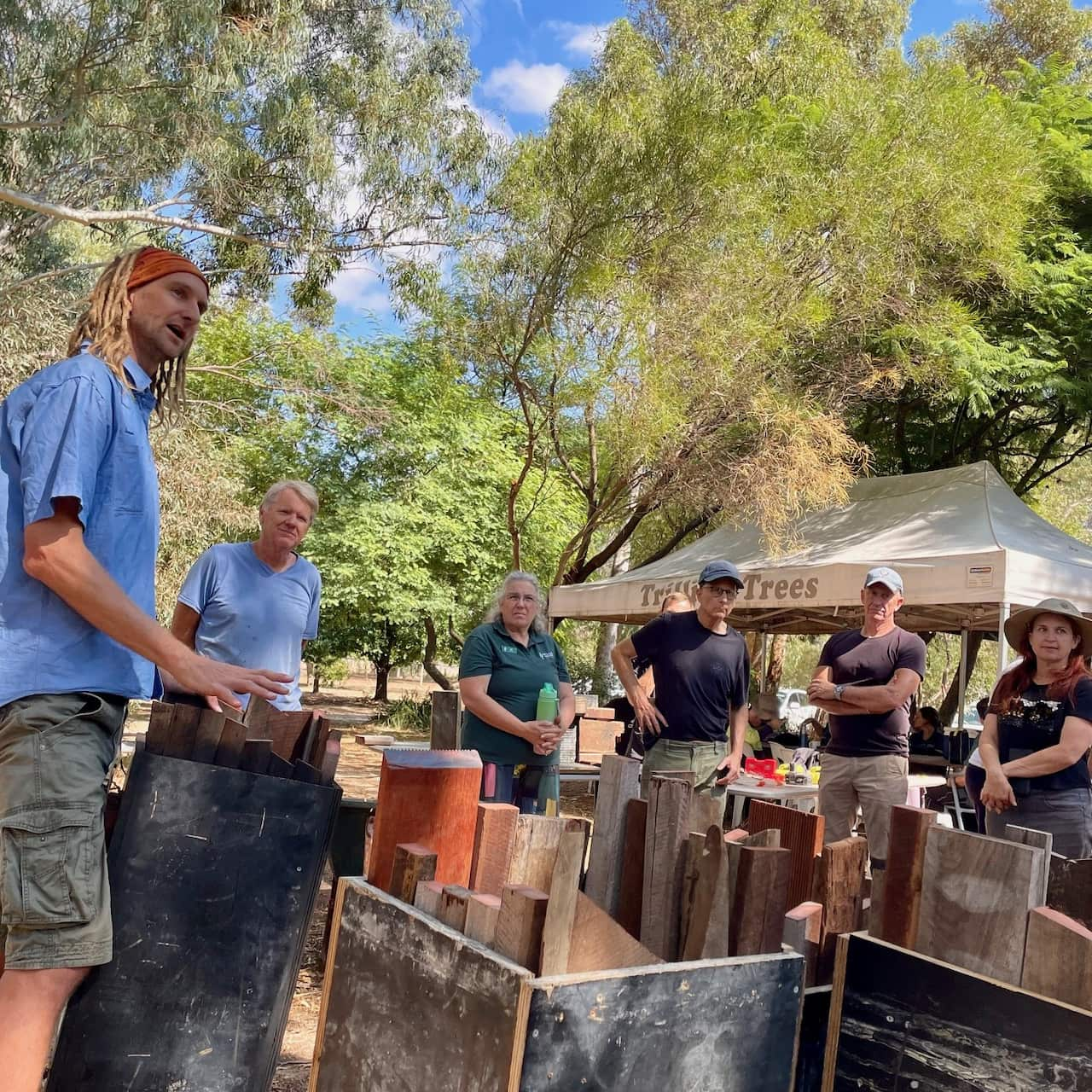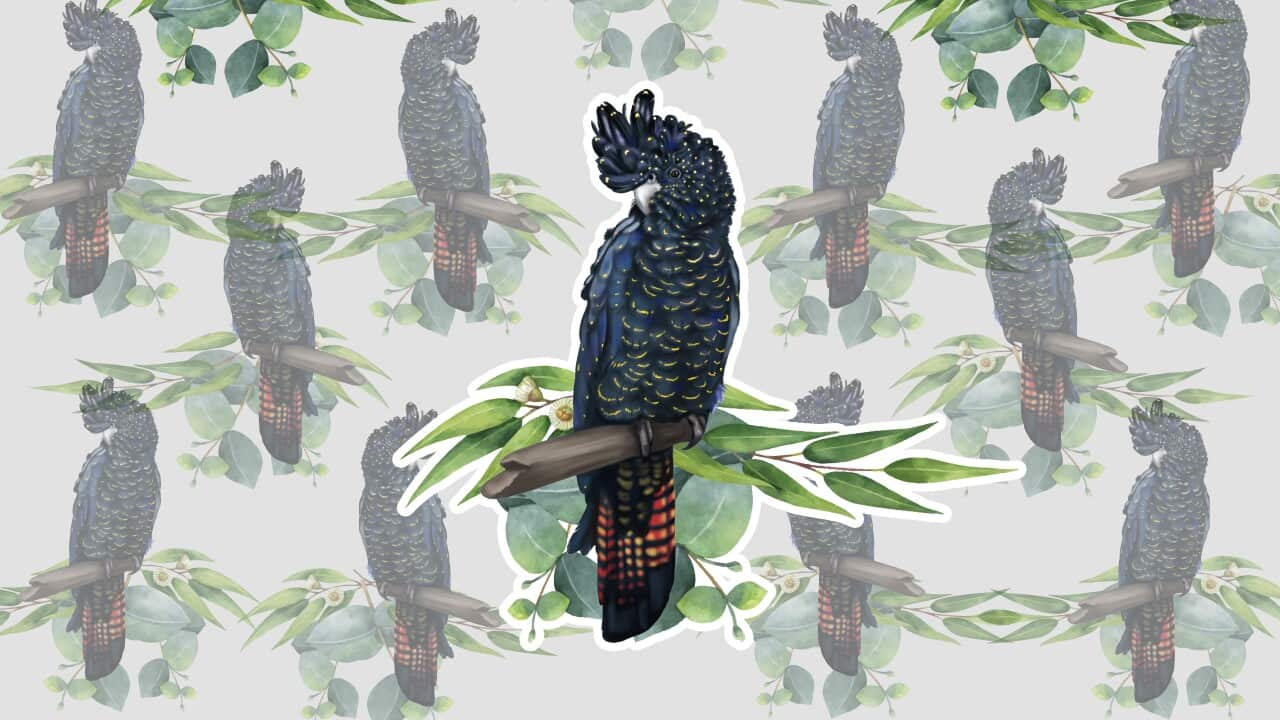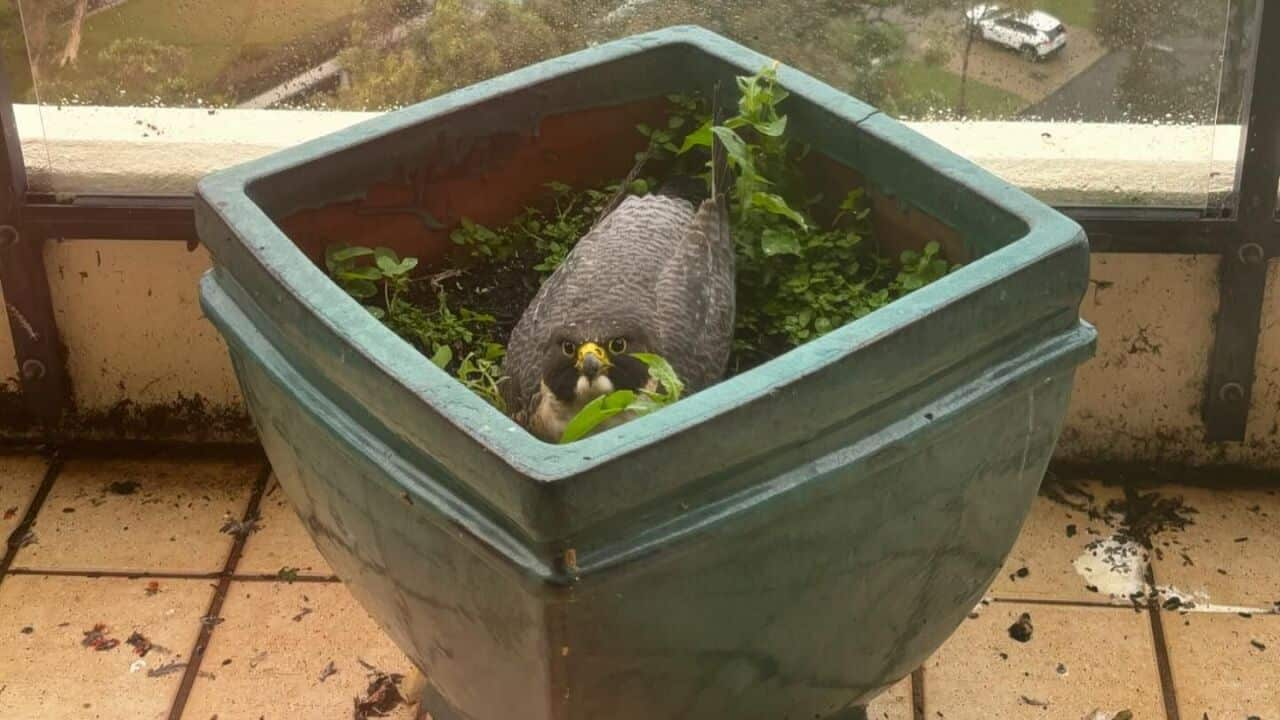In decades gone by, flocks of hundreds, even thousands, of black cockatoos used to blacken the skies along parts of Western Australia's south-west.
These days, most flocks consist of about a dozen or so.
The diminishing number of black cockatoos recently brought environmental scientist Simon Cherriman to a bush setting in the outer Perth suburb of Hazelmere, armed with a drill and some old wooden offcuts.
He was there to share his artificial nest-building skills with a group of volunteers keen to play a small part in helping to rewild the three distinct species of black cockatoo native to Western Australia.

Environmental Scientist Simon Cherriman recenlty led a workshop to teach volunteers how to make black cockatoo nesting boxes. Source: Supplied / Trillion Trees
Their heightened vulnerability has prompted communities across the country to take action to protect remaining populations and steer these majestic birds away from extinction.
The plight of three in particular has become a focus for conservationists and animal rights groups — and is now the subject of a court case.
Black cockatoos under threat
Among the four classified as threatened and the species with the smallest population is a subspecies of the glossy black cockatoo, which is now restricted to South Australia's Kangaroo Island.
While populations in Queensland and NSW are considered stable, the South Australian subspecies is believed to number fewer than 500 and is considered endangered.
Another species, the yellow-tailed black cockatoo, is found in South Australia, Tasmania and the eastern states.
Their numbers are understood to be declining due to habitat loss, but they are not currently listed as threatened under the Environmental Protection and Biodiversity Conservation Act.
Western Australia is home to the other three threatened species: the Baudin’s, which is critically endangered; Carnaby’s, which is endangered; and the forest red-tailed black cockatoo, which is listed as vulnerable.
Conservationists say if declining numbers are not turned around, all three species are expected to be extinct within 20 years.

Carnaby's black cockatoos are one of four Australian black cockatoos facing habitat loss. Source: AAP / K Lightbody
Dry summers and habitat loss
Cherriman's workshop was hosted by not-for-profit group Trillion Trees, which brought together dozens of volunteers to build 11 large nesting boxes for WA's black cockatoos.
Cherriman tells SBS News the nests mimic the natural tree hollows of hardwood native species that black cockatoos typically nest in.
The inspiration for the design came about through "many tree-climbing adventures" Cherriman had while growing up in the Perth Hills in the 1990s. He has partnered with WA Museum researchers to bring the idea to life, modelling the dimensions on actual cockatoo nest hollows.
He says the total population of Carnaby's black cockatoos today would be between 20,000 and 30,000, while the forest red-tailed species number between 10,000 and 12,000 and the Baudin's between 2,000 and 5,000.
"Forest species populations would have been 20,000 plus [previously], and Carnaby’s population would have numbered in the hundreds of thousands," he says.
In all three species, populations have declined significantly.
Land clearing for housing and industry has reduced the birds' habitat and food sources in WA.
The extremely dry conditions in the south-west of the state over summer 2023-2024, which led to mass plant deaths that scientists have likened to coral bleaching on land, have also impacted the cockatoos' ability to find food.
In 2024, Perth Zoo reported an influx in the number of black cockatoos being brought in for treatment.
Statistics provided in WA Parliament last year revealed that over a period of five months, the zoo dealt with 120 sick or injured black cockatoos, including 42 emaciated Carnaby's black cockatoos and two emaciated Baudin's black cockatoos.
Trillion Trees ecological restoration manager Doug Laurie says that "due to habitat loss and climate change, food availability is decreasing".
LISTEN TO

Red list of endangered species now counts 742 Australian species
SBS News
05:38
Local push to save black cockatoos
Residents in Perth and WA's south-west are being encouraged to plant trees to support black cockatoo populations, with groups such as Carnaby's Crusaders holding workshop events in Perth suburbs about planting food trees for black cockatoos.
While Laurie says planting natives, such as eucalypts, marri, hakea, grevillea, banksia and jarrah trees, which black cockatoos feed on and use for nesting, can help to address the loss of biodiversity in the environment, he recommends a mixed approach to planting.
"Exotic species like pecans often produce food quicker," he says.
He says access to water is also an issue for black cockatoos in WA.
While many local groups advocate installing bird baths or providing other sources of water for the birds, one council area is taking an innovative approach, rolling out bird watering stations called 'Cockitroughs'.
The Town of Victoria Park's cockatoo hydration stations provide multiple water troughs, atop 4-metre high poles, with irrigation systems to ensure a fresh water supply.
They have now been installed across a number of local government areas in WA.
Alongside efforts to improve food and water sources, a coalition of environmental groups operating under the banner Save The Black Cockatoos is also working to stop further habitat destruction for all three of WA's black cockatoo species.
Among projects the group has sought to halt is the expansion of a bauxite mine taking place across a 3,855-hectare section of jarrah forest, which is home to all three species and recently attracted the .
Community pressure also saw the WA government retract previous plans to log a 1,800-hectare pine plantation in Perth's north, where Carnaby’s have habituated over recent years for food and roosting due to a lack of native tree habitat in the area.
Not-so-glossy black cockatoos
Outside of WA, efforts to repopulate black cockatoo species have faced other hurdles.
Kangaroo Island's glossy black cockatoos — affectionately known as 'glossies' — are among the most diet-specialised birds in the world.
There were just 200 glossies in 1995, and while efforts by the Kangaroo Island Glossy Black-cockatoo Recovery Program have helped to more than double that population in the years since, the species' recovery was over 2019-2020.
The fires burned 211,474 hectares — almost half the island — destroying much of the cockatoo’s food supply and habitat. The birds feed almost solely on the seeds of drooping sheoaks, a specific genus of Allocasuarina found on Kangaroo Island, which take years to grow.

At last count there were less than 500 Kangaroo Island glossy black cockatoos. Source: Supplied / WWF-Australia / thinkMammoth
More recently, in 2023, the two conservation groups teamed up again to plant more than 19,000 sheaoks in the hope that one day they will entice cockatoos back to the mainland.
But the recovery is likely to be slow.
A November 2023 census report of the Kangaroo Island glossy black cockatoos (GBC) recorded a minimum population count of 453 birds.
It noted that it will take "an estimated 15-20 years for burnt woodlands to recover and start producing the drooping sheoak seed on which glossy GBC feed".
Therefore, the GBC population is likely to have a much lower availability of feeding habitat for years to come as a result of the fires.

WWF-Australia and Greening Australia coordinated the planting of sheoaks on the Fleurieu Peninsula, which is on the South Australian mainland across Kangaroo Island, in an effort to one day attract glossy black cockatoos back to the area. Source: Supplied / Quentin Jones/© WWF-Australia / thinkMammoth
Cockies in court
In March, the Wilderness Society launched court action against Environment Minister Tanya Plibersek, alleging she is failing to make and maintain legally required recovery plans for threatened species.
The three black cockatoo species native to WA are among the 11 species listed in the lawsuit.
The Wilderness Society has told SBS News there are likely hundreds of other species with expired plans, but it chose a selection of animals to highlight in the case as examples.
While the glossy's recovery plan, created in 2005, was meant to be in place until 2010, it has not been updated in the past 20 years, according to reports published on the federal Environment Department's website.
That means the current plan for the birds does not take into account recent habitat losses and other challenges facing Kangaroo Island's glossies.
A spokesperson for the Environment Minister did not respond to SBS News' questions about whether the existing recovery plans had expired, but indicated work on updated plans is underway.
The spokesperson also said the Albanese Government is "funding a number of projects to support the recovery of black cockatoos in Western Australia".
A WA state government spokesperson said in a statement that its Department of Biodiversity, Conservation and Attractions (DBCA) is working with the Commonwealth to develop an updated recovery plan for the three WA species.
"[The government is] committed to conserving Western Australia’s iconic black cockatoos based on expert advice," the spokesperson said.
"The DBCA continues to examine issues affecting WA’s black cockatoos and potential responses."



